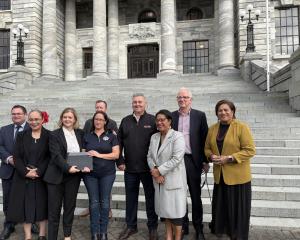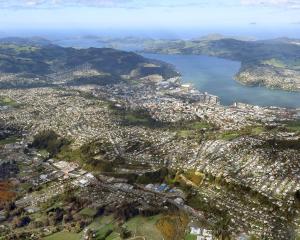
West Coasters were packing up their most precious belongings, once again, and moving to higher ground as climate scientist Tim Naish picked up the phone to talk about weather this week.
Yet another "atmospheric river" was headed for Te Tai Poutini and, kāore e kore, no doubt, people were going to get wet. An orange warning flashed the length of Westland, 700mm of rain forecast to fall over several days.
A few short years ago the notion of an atmospheric river would have been fanciful. They’ve quickly become the everyday. This latest one was a volatile mix of a spiralling Tasman low supercharged by moisture dropping down from the tropics.
"Yeah, there's a whole bunch of terms, aren’t there, in our vocabulary now," Prof Naish confirms.
A professor in earth sciences at Te Herenga Waka Victoria University of Wellington, Prof Naish will head south next week to give a key note talk at Wild Dunedin Ōtepoti Mohoao, called "A Change in the Weather".
It’s a bit of a misnomer, deliberately so, to align with the headline focus of the festival this year, which is "Huarere/Weather". And, certainly, the festival is about weather, that passing parade of beach days and jigsaw afternoons, but it’s really about climate change, the reality sitting behind it all — the world of atmospheric rivers and tumbling temperature records.
Prof Naish is in a better position than most to connect the dots between weather and climate as a result of his long involvement with research in the Antarctic, across 15 trips to the ice — he’s a former director of Victoria’s Antarctic Research Centre and led the international Antarctic Geological Drilling Project (Andrill), helping pull long ice cores from the Oligocene to show that the West Antarctica Ice Sheet may well collapse if we power planetary heating through 2°C.
So, he has watched the Antarctic sea ice retreat and the ice shelves collapse, while back in New Zealand experiencing the unprecedented extreme weather events of recent decades — the changing climate and changed weather shadowing each other.
It makes it all rather more real for him than your average weather watcher in the street.
Indeed, he says he was chatting about just that to a friend recently, while out mountain biking.
"Being climate scientists, but also earth system scientists and geologists, we see how the world has changed in the past, naturally, and how it's now changing because of human influence. We see the bigger picture, we see it because we understand it as scientists, but we also experience it first-hand ... seeing ice shelves no longer where they once were. They’ve collapsed. Seeing the sea ice around Antarctica, which forms every winter, getting smaller and smaller, seeing the changes in the Arctic, seeing the changes in the glaciers, New Zealand's own glaciers. We know too much. And we've seen too much, and it's quite hard to remain positive."
Prof Naish is not alone in his discomfort.
Further voices were raised just last month, highlighting the galloping changes on the southern continent, atmospheric rivers again part of the picture — carrying warmer weather south into the Antarctic’s usually inpenetrable cold.
A paper published in the Journal of Climate concluded there has been an "abrupt critical transition" in the continent’s climate that could have repercussions for both Antarctic ecosystems and the global climate system — based on recent changes in sea ice coverage.
That follows scientists ringing the alarm bell last year, Prof Naish among them, after observing record-low sea ice in the Southern Ocean, something they estimated was a "one in 7.5million year" event. The previous year scientists had recorded the largest jump in temperature measured at a meteorological centre on Earth — a pole vault of 38.5°C above the seasonal average in Antarctica.
So, that’s the climate, apparently on a runaway, fossil-fuelled train to somewhere we’d be better off avoiding. Which is different, it’s important to remember, to the weather.
"Weather's what we experience every day," Prof Naish clarifies. "And, you know, we can forecast that quite accurately five days in advance, and some of our models go out several weeks. But climate is more the long-term variability — climate is something that occurs over years, to decades, to centuries, and it's the average of the weather, really, the long-term average of the weather."
It is the background state for the weather, so can, depending on what it is doing, amplify the weather, make it more extreme.
That background now is global warming, which has been going on for the last century or more, he says.
"That is really causing some changes, not only in our climate, but in our weather."

Auckland’s floods and Marlborough’s droughts are all part of the picture, climate and weather.
There has been an extra edge to global concern recently, as average temperatures for the past 12 months have pushed up beyond the 1.5°C limit set by world governments in Paris in 2015.
It is thought that the El Nino weather pattern has been a significant contributor, releasing ocean heat into the atmosphere.
However, data released earlier this month by the Copernicus Climate Change Service adds a further worry line.
March 2024 was warmer globally than any previous March in the data record, the service says, the 10th month in a row that is the warmest on record for the respective month of the year. The month was 1.68°C warmer than the historical average.
And writing in Nature, the director of Nasa’s Goddard Institute for Space Studies, Gavin Schmidt, said "even after taking all plausible explanations into account, the divergence between expected and observed annual mean temperatures in 2023 remains about 0.2°C — roughly the gap between the previous and current annual record".
"If the anomaly does not stabilise by August — a reasonable expectation based on previous El Nino events — then the world will be in uncharted territory," he wrote. "It could imply that a warming planet is already fundamentally altering how the climate system operates, much sooner than scientists had anticipated."
That won’t be helped by the latest inventory of the three big planet-cooking gases in the atmosphere — CO2, methane and nitrous oxide — which achieved record highs again last year. The big one, CO2, rose to an average of 419 parts per million.
Down in the Antarctic, Prof Naish has continued to observe the retreat.
"More recently, I've been going on cruise ships out of South America into the Antarctic Peninsula, and giving lectures on all this stuff. And the changes are far more dramatic there because it's warming at a greater rate than the Ross Sea," he says.
It is though, more of the same.
"When I first went down to Antarctica with the New Zealand programme, I landed in a thing called a Galaxy, which is a massive Airforce cargo plane."
The Lockheed C-5 Galaxy would land on the sea ice in front of McMurdo Station.
"It couldn't stay there for long because it would sink and the sea ice would bend under it, but it could do it. Now, we don't even land anything on the sea ice because the sea ice outside of McMurdo is unreliable. It's not strong enough.
"So, now we land on a blue ice runway, which is on the actual ice shelf itself. But temperatures every year are so warm now that over the height of summer, you can't land a wheel plane."
The programme must rely on Hercules fitted with skis to fly people in and out.
"So even from a practical point of view, just by flying down there, you can see the big changes. Not to mention the obvious physical changes, and the effects on the biology as well, such as the penguin colonies.
"So it’s in your face, that's for sure. Especially if you've been going a lot over a long period of time."
For his Wild Dunedin talk, Prof Naish will be bringing it home to New Zealand, what it means for us.
"Antarctica is particularly important because it's a major contributor to sea level rise. So I'll talk about ice sheets melting and sea level rising.
"I'll also talk about the other impacts that we're feeling from climate change, such as more extreme events, the droughts, the rainfall events."
The picture is that there are now some things that we can’t avoid, but on the more optimistic side of the ledger, some things that we can — if we get on top of our mission, globally, to cut emissions, he says.
His message, he says, will be rational, honest and clear.
"But also still hopeful, and empowering — there are still things we can do. And should do and must do."
Part of it is to not give up hope as we crash through targets such as the 1.5°C limit identified in Paris. It would be easy to conclude that we’ve failed, he says.
"No, we haven't failed. Because we're a lot closer to two degrees than we are five degrees. And so don't give up. But yes, be prepared, be prepared for some things we can no longer avoid.
"The message is still that the science empowers. The science gives you options, the science gives you time, to still reduce your carbon emissions, potentially remove some of them out of the atmosphere, but also time to protect and adapt and just make sure people are safe. If you live near the coast, if you live near a river on a floodplain, there is still time."
Precisely what we need to do now is back before the public, as the Climate Change Commission consults on our national greenhouse gas emission targets.
Prof Naish says the commission is certainly aware of his views on our plans to go net zero.
"I think, in general, it lacks innovation. It's not ambitious. But the climate commission is giving advice to government and government then decides what to do with it. It's not [the commission’s] fault."
As the climate change storm clouds have gathered, distributing their payloads liberally around the motu, around the globe, Prof Naish’s climate talks have changed to accommodate the rising tide of anxiety in his audiences — about all this weather.
"More and more, I've started to talk about what you can do and solutions, both for reducing your carbon footprint, but also for, you know, being aware of the dangers and the hazards and not buying a house in an exposed coastal position.
And that's more and more because people always say, ‘Well, what should we do about it?’.
I used to say, ‘well, that's a personal decision’, or ‘it's a policy thing’, and I didn't want to get involved.
I'm not an expert. I’m a scientist, I am not really the expert in the solutions.
But now I just generally throw up a slide that lists a whole bunch of things that you can do, from grassroots, bottom-up level, to make a significant difference. And every little difference helps."












